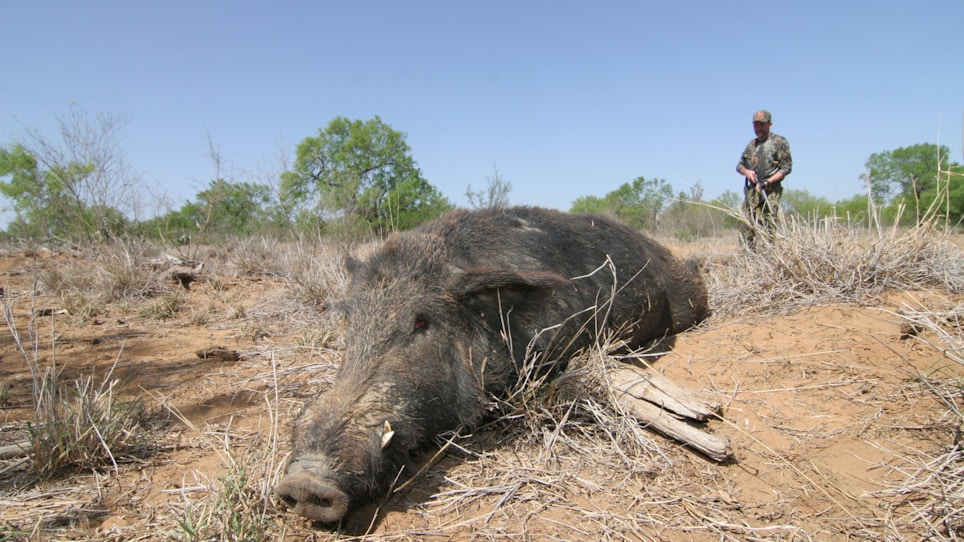
A perfect shot with a CVA Optima Elite dropped this 250-pound feral hog. Hunters have plenty of options for pursuing feral hogs in the United States due to their prolific reproduction habits and ample habitat. (Photo: Mark Kayser)
If you’ve never studied feral hogs before, here are some eye-openers to ponder about this invasive and opportunistic freeloader. Digest these numbers and you may be more inclined than ever to take up arms against this invader.
Let’s start the numbers game with population. Biologists and wildlife managers estimate that the nationwide population of feral hogs is more than 6 million and expanding by the minute. They’ve raided at minimum 35 states and because they are extremely adaptable to various environments, look for them in a zip code near you soon.
Feral swine were brought to the United States in the early 1500s as a food source for early explorers. Seems everyone loves bacon. Free-range practices and escape-artist hogs led to feral hog populations in ideal environments to bolster their expansion. If that wasn’t enough, in the 1900s the Eurasian or Russian wild boar was released for hunting in the country. Combine those hardy souls with escapees from modern domestic pig operations and the life cycle is never ending for this interloper.
Setting aside mythical stories about Hogzilla, the average sow weighs in at 110 pounds with the average boar at 130 pounds. Of course each year monster hogs surface that are more than 3 feet at the shoulder, 6 feet long and pushing more than 500 pounds of prime bacon. Did you notice the bacon theme?

Although farmyard hogs appear cuddly and cute, feral hogs can turn vicious in the blink of an eye when defending young, or if wounded and cornered. Where’s the danger from this flat-nosed meat source? Hogs have tusks and for boars they average 3 to 5 inches in length with some reaching more than 8 inches. Whereas the upper tusks curl up and along the sides of the mouth, the lower tusks, or canines, turn and curve back toward the eye.
After years of fighting amongst each other hogs have developed a thick, tough skin of cartilage and scar tissue in the shoulder vicinity. This makes it all that more important to plant a killing shot. Companies like Hornady have even developed ammunition for feral hogs like their popular line of Full Boar. Not only is it California compatible, it retains 95 percent or more of its weight upon impact for a bacon-possible ending.
Hogs have a love for all foods, green or red. The reason: hogs are omnivores. They eat what’s in season regardless of its makeup. They’ll graze, browse, root, scavenge and even kill to fill their stomachs. They raid gardens and croplands, eat carrion and kill mammals, and birds. Dense populations of feral hogs are very destructive. Farmers and landowners alike welcome serious hog hunters when damage begins adding up.
Here is the tally on damage. This invasive species costs the farmer and consumer — you — an estimated $1.5 billion each year for crop damage and control. They also have the potential to threaten your health, wildlife populations and the wellbeing of domestic animals, including Fido.
As you ponder the numbers plan on adding a hog hunt to your calendar this year. It’s good for the environment and good eating too. Can you pass the bacon, please?





